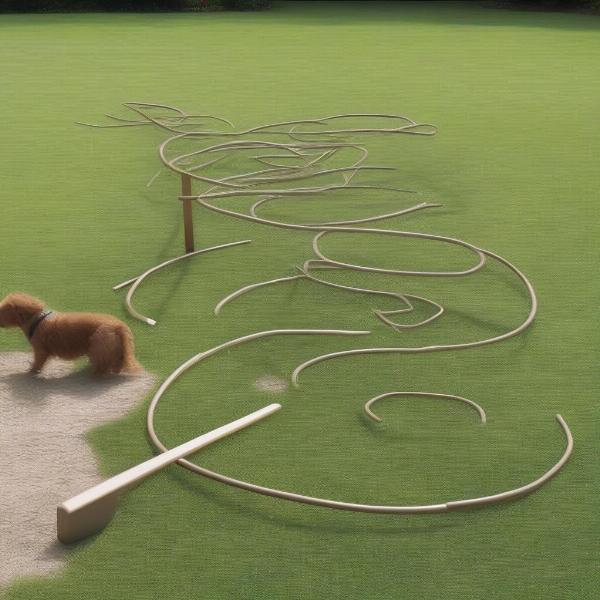Dog stakes are an essential tool for any dog owner who wants to provide their furry friend with a safe and secure outdoor space. Whether you’re setting up a temporary tie-out for camping or creating a more permanent boundary in your backyard, choosing the right dog stake is crucial for your dog’s safety and your peace of mind. This guide will explore the different types of dog stakes available, helping you select the best option based on your dog’s size, breed, temperament, and specific needs.
Types of Dog Stakes
There’s a wide variety of dog stakes available, each designed for different purposes and dog breeds. Understanding these differences will help you make an informed decision.
Spiral Stakes
These are ideal for softer ground like grass or sand. Their spiral design provides excellent holding power, making them difficult for even strong dogs to pull out. Spiral stakes are typically lightweight and easy to install. They are a great option for smaller to medium-sized dogs.
 Spiral Dog Stakes for Soft Ground
Spiral Dog Stakes for Soft Ground
T-Post Stakes
T-posts, also known as metal fence posts, are heavy-duty stakes that offer exceptional strength and durability. They’re suitable for harder ground and are perfect for containing larger, more powerful breeds. These stakes are driven deep into the ground and are incredibly difficult to dislodge.
Auger Stakes
These stakes have a screw-like design that burrows into the ground, providing excellent holding power in various soil types. They are a good option for dogs who tend to pull or dig. Auger stakes are typically heavier than spiral stakes but offer more stability.
Rock Stakes
Rock stakes are designed specifically for rocky terrain where traditional stakes are difficult to install. They have a pointed tip that can be hammered into crevices between rocks. These are particularly useful for camping or hiking in rocky areas.
Factors to Consider When Choosing Dog Stakes
Selecting the appropriate dog stake depends on several factors:
- Dog’s Size and Strength: Larger, stronger dogs require more robust stakes like T-posts or heavy-duty auger stakes. Smaller breeds can be safely secured with spiral stakes.
- Soil Type: Spiral stakes work best in soft ground, while T-posts are ideal for harder soil. Auger stakes offer versatility for various ground conditions. Consider rock stakes for rocky terrain.
- Tie-Out Length and Area: The length of the tie-out will influence the stake’s required holding power. A longer tie-out requires a more secure stake. The area where the dog will be tied should be free of obstacles and hazards.
- Dog’s Temperament: For dogs that tend to pull or dig, choose stakes with superior holding power, such as auger stakes or T-posts.
Dog Stake Safety Tips
- Always supervise your dog when tied outdoors.
- Check the stake regularly for any signs of wear or damage.
- Ensure the tie-out cable or rope is securely attached to both the stake and the dog’s collar.
- Never use a choke chain or prong collar with a tie-out.
- Provide your dog with access to fresh water and shade when tied outdoors.
How to Install Dog Stakes Correctly
Proper installation is key for a secure and safe tie-out. Follow these general guidelines:
- Choose the right location: Select a level area free of obstacles.
- Drive the stake firmly into the ground: Ensure the stake is angled slightly away from the direction of pull.
- Test the stake: Give it a firm tug to ensure it’s securely in place.
Conclusion
Choosing the right dog stake is crucial for your dog’s safety and well-being. By considering factors such as your dog’s size, temperament, and the type of ground you’re working with, you can select the most appropriate stake for your needs. Remember to always prioritize safety and supervise your dog when tied outdoors. With the right dog stake and proper precautions, you can provide your furry friend with a safe and enjoyable outdoor experience.
FAQ
-
What type of dog stake is best for sandy soil? Spiral stakes are generally the best option for sandy soil.
-
Can I use a dog stake for a very large, powerful breed? Yes, but you’ll need a heavy-duty stake like a T-post or a large auger stake.
-
How do I prevent my dog from pulling out the stake? Ensure the stake is driven deep into the ground and angled slightly away from the direction of pull. Choose a stake appropriate for your dog’s size and strength.
-
What should I do if my dog keeps digging around the stake? Consider using a stake with a larger base or burying a barrier around the stake.
-
How often should I check my dog’s stake? Regularly check the stake for any signs of damage or loosening.
ILM Dog is your trusted source for expert advice on all aspects of dog care, including breed selection, health, training, nutrition, grooming, and accessories. We offer a wealth of information to help you provide the best possible care for your canine companion. For personalized guidance and product recommendations, contact us at [email protected] or call us at +44 20-3965-8624. ILM Dog is committed to helping you and your furry friend live a happy and healthy life together.